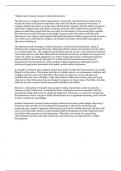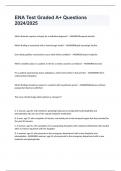“Explain and evaluate caregiver-infant interactions.”
The first type of caregiver-infant interaction is reciprocity. An interaction is said to show
reciprocity when each person responds to the other and elicits a response from them. A
caregiver infant interaction is reciprocal in that both the caregiver and the infant respond to
each other’s signals and each elicits a response from the other. Babies have periodic alert
phases in which they signal that they are ready for interaction. From around three months
this interaction tends to become increasingly frequent and both mother and baby play
attention to each others verbal signals and facial interactions. Babies appear to take an active
role within care, and both the caregiver and infant can initiate interactions and appear to
take turns in doing so.
The alternate form of caregiver-infant interaction is interactional synchrony, which is
defined as the caregiver and the baby reflecting both the actions and emotions of each other
in a synchronised way. The caregiver and the baby interact in such a way that their emotions
and actions mirror each other. Research has illustrated synchrony in infants as young as two
weeks old, where an adult displayed one of three facial expressions or distinctive gestures
which would be mirrored by the infant. It is believed that interactional synchrony is
important for the development of the caregiver-infant attachment, with high levels of
synchrony being better associated with quality mother-baby attachment.
A strength of research into caregiver-infant interactions is that these interactions are usually
filmed in a laboratory. This means that there is a high control over extraneous variables, and
multiple observers can watch the films. More than one observer can record data and
establish the inter-rater reliability of the observations. Babies do not know they are being
observed so their behaviour does not change in response to observation. Therefore, the data
collected in such research should have good reliability and validity.
However, a limitation of research into caregiver-infant interactions is that it is hard to
interpret a baby’s behaviour. Young babies lack coordination and are immobile, with the
movements being observed very small and subjective. Therefore, we cannot be certain that
the behaviours seen in caregiver infant interactions have a significant meaning, and it is hard
to draw conclusions accordingly.
Another limitation of research into caregiver-infant interactions is that simply observing a
behaviour does not tell us its developmental importance. Ideals like synchrony and
reciprocity give names to patterns of behaviours, and can be reliably observed, but they still
may not be especially useful in understanding child development and observing them does
not disclose the purpose of such interactions. Therefore, we cannot be certain from
observational research alone that reciprocity and synchrony are important for a child’s
development.
, “Schaffer’s stages of attachment.”
Schaffer and Emmerson investigated the attachment behaviours of babies. They completed
an observational study on 60 Glasgow babies from working class families. The researchers
visited babies and their mothers in their own homes every month for the first year and again
at 18 months, asking the mothers questions about the kind of protest babies demonstrated
and assessed stranger anxiety. They established 4 key stages involved in the infants’
developmental processes. The first of which is the asocial stage, where an infant does not
discriminate between humans and inanimate objects. Babies did tend to show a preference
for familiar people, and are more easily comforted by them. However, they do not show any
key attachments within the asocial stage. The second stage emerges at around ages 2-7
months, known as indiscriminate attachment, where babies begin to display more obvious
social behaviours. They show a clear preference for humans rather than objects. However, at
this stage, the infants do not discriminate between humans and accept cuddles and comfort
from anyone. They do not show separation or stranger anxiety. From around 7 months, the
majority of babies show attachment towards a primary attachment figure, in the specific
attachment phase. These signs include anxiety towards strangers and separation anxiety
when separated from the primary attachment figure. The primary attachment figure is not
necessarily the individual that the baby spends the most time with, but more specifically the
one who offers the most interaction and responds to the babies’ needs with skill. Shortly after
babies begin to show attachment behaviour towards one person, they typically extend this
behaviour to multiple attachments with other people with whom they spend time. These
relationships are known as secondary attachments.
One strength of Schaffer and Emmerson’s research is that it has high internal validity. Most
of the observations were made from parents during ordinary activities, and reported to the
researchers. This means that it is highly likely that the participants behaved naturally when
being observed, and thus it maintains high internal validity. Therefore, we can be confident
in the conclusions of the stages drawn from the research.
However, this strength has been contested. There are issues with asking the mothers to act as
observers, as they are unlikely to be objective and may have been biased in terms of what
they noticed and what they reported. For instance, they may have misremembered instances
or potentially were unlikely to report sensitive incidences due to social desirability bias.
Therefore, the study may lack an essential objective nature that reduces it’s validity overall.
Another limitation of Schaffer and Emmerson’s research is that it used a limited sample size
of 60 babies, originating from the same area and same class. Therefore, the results observed
may be specific to only one culture and class, and therefore such results may not have been
obtained if the research was committed into a collectivist culture, for instance. Therefore, the
study generates results that may only be applicable to the time and situation that they arised
in, reducing the external validity of such findings.
Another limitation of Schaffer and Emmerson’s research is the validity of the measures that
they used to assess attachment in the asocial stage. Young infants have poor coordination
and are fairly immobile, and therefore if infants that were older than 2 months felt anxiety it
would be difficult to observe and discern this emotion. Equally, babies may appear social at
older stages despite feeling concealed anxiety. Therefore, it is difficult to make judgements
and conclusions about behaviour.





